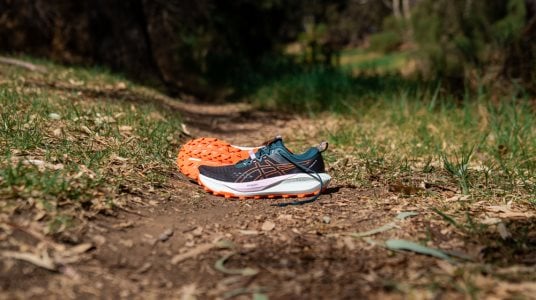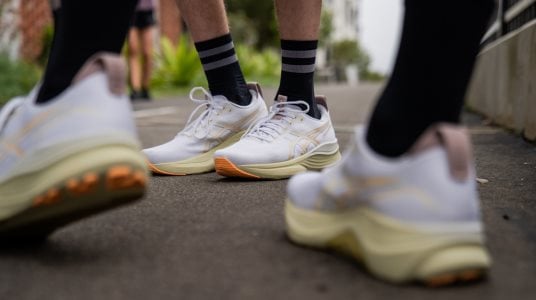RunDNA: Midsoles Explained

If the upper is the first thing you notice on a shoe and the outsole is what meets the ground, then the midsole is where the magic really happens. It’s the beating heart of a shoe’s ride, responsible for cushioning, responsiveness, energy return, and even stability. Whether you're an everyday runner, a weekend hiker, or just someone who spends hours on your feet, the midsole plays a critical role in how your shoes feel and perform.
In this blog, we’ll break down the midsole into its core components and design principles so you can better understand what’s going on underfoot.
What is midsole geometry?
When we talk about midsole geometry, we're referring to the shape and sculpting of the foam underfoot, how it’s carved, beveled and contoured. Brands design midsoles not just for design, but for comfort, how they influence the foot's movement and help support your overall movement pattern.
Some shoes feature wider base platforms, especially at the heel and midfoot to increase inherent stability. This is great for runners who need a bit of support without turning to traditional stability features. Additionally, the use of midsole sidewalls can be used to “cradle” the foot for stability. Beveled heels and forefoot rockers are another aspect of midsole geometry and can also promote smoother transitions by encouraging heel to toe motion.
Midsole geometry is a crucial aspect of the overall engineering of a running shoe. Daily trainers typically feature more simple geometries for comfort and versatility across a range of runs. In contrast, super shoes often have exaggerated rockers, higher stack heights and more narrow platforms to drop weight and enhance forward propulsion. By adjusting the geometry of the midsole, brands can optimise the shoe’s performance to meet the specific run types.
What are common types of midsole materials?
Midsole foams have come a long way since the days of just simple EVA (ethylene-vinyl acetate). Brands will select the material that best suits the category of the shoe and will often blend or tune the foam to match a shoe's intended purpose, depending on whether it’s a durable daily trainer or a performance super shoe.
1) EVA (Ethylene-Vinyl Acetate)
Lightweight, relatively soft and easy for brands to shape. This is the most widely used midsole foam used today, especially in daily trainers, but is a much improved material from the EVA used 5-10 years ago. EVA midsoles have great shock absorbing properties mixed with solid durability, however they tend to compress and break down slightly faster than TPU compounds. Some popular models that use this midsole type include the Hoka Clifton 10, New Balance 1080v14, Brooks Ghost 17 and Asics Novablast 5.
2) TPU (Thermoplastic Polyurethane)
This midsole material offers more durability and higher energy return than EVA. It’s often heavier, but provides a bouncy, resilient feel. You should expect to get a full 800km out of a TPU based midsole which is a huge benefit of this type of foam. It’s also a material that typically doesn’t change cushion properties when exposed to hot and cold temperatures. Saucony uses this type a foam in a number of their shoes such as the Triumph 22 and Ride 18.
3) PEBA (Polyether Block Amide)
Considered the gold standard in performance running shoes and often referred to as "super foam," PEBA is exceptionally lightweight, offering excellent energy return and responsiveness that contributes to a springy, propulsive feel with each stride. This material was first used in running shoes by Nike in 2017, when they debuted the original Vaporfly, a shoe that changed the shoe industry for its performance benefits over the marathon.
The higher cost of PEBA based shoes reflects the material’s advanced properties, but its role in modern racing footwear is significant. The Asics Metaspeed Paris, New Balance Supercomp Elite v4 and Nike Alphafly 3 are just a few examples of super shoes with this type of midsole foam. However, we are beginning to see this material trickle down and be used in super trainers such as the Asics Superblast 2, Hoka Mach X 2, On Cloudmonster Hyper and some daily trainers like the Nike Vomero 18.

What is a rocker sole?
One of the most influential trends in recent shoe design over the past 10 years is the concept of a rocker sole. Rocker geometry refers to how the midsole is curved, both at the heel and forefoot to promote a smooth, rolling transition through each step.
The rocker at the heel, often referred to as a 'heel bevel' helps ease impact and transition you forward during initial contact whereas forefoot rockers aid in toe-off, propelling you forward with less effort.
Rockers can vary widely in aggressiveness. Some shoes have subtle curves that simply smooth the ride, while others, especially performance models, feature dramatic rockers that actively push you forward with each step.
Can a rocker sole help with injuries?
Yes, rocker soles aren’t just performance tools, they can also be useful in managing niggles or biomechanical limitations. The unique shape of a forefoot rocker can reduce load and strain on key areas of the lower limb. We've found a number of shoes such as Brooks Ghost Max 2, Hoka Bondi 9, Asics Nimbus 27 and New Balance Supercomp Trainer v3 have sold well instore for runners in managing the list below:
1) Reduced forefoot loads
The curved design of a rocker shifts pressure away from the toes and the ball of the foot by shortening the time you spend on the forefoot during each stride. This makes rocker shoes helpful for runners managing forefoot injuries or even plantar heel pain.
2) Achilles management
Rocker soles decrease the range of motion needed at the ankle during toe-off, easing tension on the Achilles tendon. The rolling motion encourages less ankle dorsiflexion and calf engagement, making them a useful option for those managing Achilles tendon discomfort or prone to overloading this area.
3) Arthritis or foot joint pain
For people with arthritis in the toes or midfoot, the rocker can reduce the need for excessive joint flexion. By allowing forward progression without requiring a full range of motion at the metatarsophalangeal joints (toes), rocker soles enable a more comfortable walking or running experience.

What is a heel to toe drop?
Heel to toe drop (also known as pitch) is the difference in height between the heel and forefoot in a running shoe and is an important design characteristic that can influence running mechanics and comfort. In traditional running shoes, the drop typically ranges between 8–12mm. This higher drop often suits heel strikers and has historically been used to help reduce strain on the Achilles tendon and calves. However, in recent years, especially with the rise of maximalist designs, there’s been a noticeable shift towards lower drops in the 4–8mm range with a rocker sole geometry.
It’s important to recognise that drop is a static measurement and the way it’s experienced by runners is dynamic. The actual effect of drop is significantly influenced by the midsole foam properties (soft vs firm), overall shoe geometry and the individual wearing the shoe.
In the past, lower drop shoes were associated with a greater demand on the ankle and Achilles, often requiring more strength and mobility in those areas. But modern high stack, rocker sole shoes have changed that narrative. Many of these lower drop models now help to deload the Achilles and calf complex, making them suitable for runners managing lower leg niggles or recovering from injury. The presence of a forefoot rocker, in particular, can facilitate forward momentum with less reliance on ankle motion.
Ultimately, drop is just one piece of the puzzle. It works in conjunction with the shoe’s stack height, midsole foam and other structural features to create a unique ride experience. There is no universally "best" drop, what works best will depend on your individual biomechanics, injury history, preferences and what simply feels right underfoot.

Wrap up
The midsole is where biomechanics, material science and creative engineering come together. Whether it’s through carefully sculpted geometry, advanced foam compounds, or the flow of a rocker design, the goal is always the same, to help you move more efficiently, comfortably and confidently.
Understanding what’s going on beneath your feet can help you to choose the right shoe for your needs and appreciate just how much thought goes into the gear that helps you go the distance.
About the author
Nathan Pope - Runner and Shoe Nerd
I'm really passionate about running footwear and how shoes can be used as a tool to get the best of your running, whether that be general fitness or performance.
My favourite event is the marathon. I feel as though the marathon is the ultimate test both physically and mentally! It requires careful planning both within the race and during the training block and it can be super satisfying when it comes together on race day.


